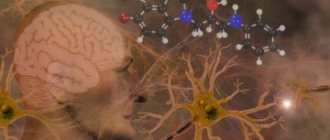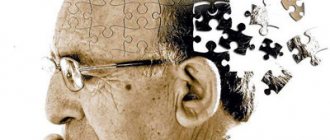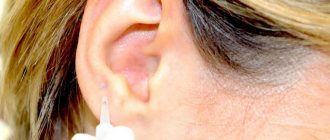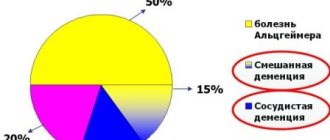Both dementia and Alzheimer's disease are similar in their presentation and share many of the same features. In both cases, memory, speed of reactions, acuity of thinking, speech functions and personality traits are affected. Both diseases are associated with age-related changes.
It is this similarity that often causes incorrect diagnosis and the prescription of inappropriate drugs.
How are these diseases different and what are their symptoms?
What is senile dementia?
Dementia is a syndrome characterized by:
- Degradation of thinking abilities (confusion).
- Impaired functions of memory, thinking, understanding.
- Speech dysfunction.
- Deterioration of emotional state and control over it.
- Degradation of motivation and behavior in society (aggression, disorientation in time and space, personality disorders, etc.).
In other words, dementia is a chronic or progressive weakness of the mind. The reason is pathological changes in the cerebral cortex of various etiologies, which entails a profound disruption of its activity.
Signs that may indicate the early stages of dementia:
- Difficulties in remembering information, complicating routine activities.
- A person loses the ability to plan and think abstractly.
- The ability to solve simple everyday problems is lost.
- The appearance of problems with speech and writing.
- The person does not remember his last actions.
- Loss of the ability to reason and draw conclusions, logic is lost.
- Sudden and frequent mood changes.
Reference! Dementia cannot be called a disease, since its presence in a patient can indicate a variety of pathologies and be their consequence. Therefore, dementia is considered a syndrome.
In the video, the doctor explains what dementia is and how to recognize it in the early stages:
Symptoms of dementia in Alzheimer's disease
At the beginning of the development of the disease, prolonged and treatment-resistant neuroses, depression, paranoid episodes, and psychotic disorders are observed. The patient himself notes a decrease in memory and tries to compensate for it. Orientation in unfamiliar places is impaired, counting and writing become difficult.
The behavior of patients is marked by untidiness, frequent “getting ready for the trip,” and stereotypic behavior. Then the memory impairment is not realized by the patients and spreads to habitual actions - patients forget to shave, dress, and wash. Last but not least, the memory associated with professional skills is impaired.
As the disease progresses, disturbances of other higher cortical functions—praxis, gnosis, and speech—are added. Epileptic seizures and psychotic episodes are possible. In bed, patients make stereotypical movements (covering their heads, “rummaging” movements) or lie motionless. Muscle rigidity and general stiffness increase, and parkinsonism is possible. The addition of somatic pathology can cause delirium.
Features of vascular dementia
Before we talk about the differences, it is worth mentioning the causes, symptoms and signs of vascular dementia.
Causes:
- Stroke.
- Cerebral ischemia with a chronic course.
- Large and small heart attacks.
Vascular dementia always has two distinctive features:
- Vascular disorders of the brain.
- Cognitive behavioral disorders.
The combination of these two signs allows us to talk about vascular dementia.
Symptoms that are highly likely to diagnose vascular dementia:
- Epileptic seizures.
- Movement disorders.
- Urinary dysfunction (observed in 90% of cases).
- Periods of short-term restoration of functions, reaching almost normal levels.
- Smooth progression. Sometimes there is some restoration of body functions. but it never reaches its original level.
Comparison of Alzheimer's dementia with its other forms
The difference between Alzheimer's and other types of dementia is quite simple to detect. You just need to know what features are characteristic of other pathologies accompanied by the development of dementia.
Senile dementia
Senile dementia is considered as a general definition for all kinds of intellectual disorders associated with the degeneration of brain cells with aging. Senile dementia differs from Alzheimer's, because dementia in the syndrome is only one of the forms of age-related dementia, which includes disorders associated with Pick's disease, Parkinson's disease, vascular and other pathologies, as well as physiological dementia that develops during the aging process.
How is Alzheimer's disease different?
First of all, it should be said that Alzheimer's disease is a disease that always results in dementia. And dementia is a syndrome , that is, a set of symptoms that appear simultaneously.
Moreover, this syndrome can indicate the presence of a variety of diseases, including Alzheimer’s disease.
Dementia has many causes and they can be identified, usually:
- Head injuries.
- Stroke.
- Ischemia.
- Alzheimer's disease.
- Parkinson's disease.
- Lewy body disease.
- Brain tumors.
- Genetic predisposition.
- Congenital mental retardation.
- Damages to the cerebral cortex, which resulted in the death of its cells. (autoimmune disorders, endocrine diseases, infections, etc.).
Another difference is irreversibility. Alzheimer's disease is always irreversible. Other types of dementia may be treatable.
Important! The main difference between Alzheimer's disease and other types of dementia is that Alzheimer's disease leads to dementia in 100% of cases. However, the cause of dementia is not always Alzheimer's disease.
The difference between Alzheimer's disease and dementia is explained in the video:
Treatment of dementia due to Alzheimer's disease
- Drug therapy (nootropics, cholinesterase inhibitors, vitamin therapy, antiparkinsonian drugs, vascular drugs, neurometabolites; limited use of tranquilizers and antipsychotics).
- Instructing relatives.
Treatment is prescribed only after confirmation of the diagnosis by a medical specialist.
Essential drugs
There are contraindications. Specialist consultation is required.
- Ipidacrine (anticholinesterase agent). Dosage regimen: orally, at an initial dose of 20 mg/day. (in two doses), then it is increased over 2-4 weeks. before therapeutic (40-80 mg/day in two doses). The duration of treatment is at least 3 months.
- Galantamine (anticholinesterase agent). Dosage regimen: orally, at an initial dose of 8 mg/day. (4 mg morning and evening) for 4 weeks. With good tolerance from the 5th week. the daily dose is increased to 16 mg (8 mg in the morning and evening). With insufficient effectiveness and good tolerability from the 9th week. treatment, the daily dose can be increased to 24 mg (12 mg in the morning and evening). Duration of treatment is at least 3-6 months.
- Memantine (neuroprotective agent). Dosage regimen: orally, at an initial dose of 5 mg (once in the morning), every 5 days the daily dosage is increased by 5 mg (in two doses) until the therapeutic dose is reached. The course of treatment is at least 3 months.
- Piracetam (nootropic drug). Dosage regimen: orally, with liquid at a dose of 400-800 mg in 3 divided doses.
- Cerebrolysin (nootropic drug). Dosage regimen: intravenously, at a dose of 20-30 ml of the drug in 100 ml of 0.9% sodium chloride solution, 20 infusions per course. A course of treatment with Cerebrolysin 1-2 times a year is recommended.
Stages of Alzheimer's disease
Alzheimer's type dementia is divided into three stages:
- Early . It usually occurs after the patient crosses the 60-year mark. Characteristic signs: memory impairment; disturbance of orientation in space (the patient does not remember or does not understand where he is); slowness; asking the same questions; distorted assessment of what is happening; change in personal qualities; sudden mood swings.
- The moderate stage is characterized by: confusion; severe memory loss; loss of everyday skills; lack of ability to learn and adapt; the presence of obsessions, various manias or phobias; Sometimes patients exhibit sexual preoccupation, gluttony, and a tendency to wander.
- The severe stage of the disease occurs in the complete absence of interaction between the patient and the outside world. Characteristic signs: complete apathy, weight loss, convulsions, drowsiness, reflex emptying of the bladder and bowels. Mental activity stops completely, and the patient may not feel pain, thirst, hunger or cold.
Common symptoms
Losing your keys and forgetting where your car is parked are major memory problems. It can be difficult to notice when symptoms cross the line of age-related dementia and develop into Alzheimer's disease. According to the Alzheimer's Association, two of the following factors must be diagnosed to make a more accurate diagnosis:
- poor memory;
- communication and language difficulties;
- difficulties with concentration and attention;
- erroneous reasoning and judgment;
- disturbance of visual perception.
When it comes to Alzheimer's disease, people quickly forget a lot of new information. A study published in the Journal of Alzheimer's Disease in 2020 suggests that problems using the roadmap may be one of the first warning signs of Alzheimer's disease , and this is one of the warning signs to look out for.
What is the difference between diabetes and asthma?
In addition to these tests, MRI (magnetic resonance imaging) of the brain can clearly show the specific area of the brain that was damaged due to a stroke or transient ischemic attack.
Important
Otherwise, this disease is diagnosed by excluding similar pathologies, since at present it is impossible to establish an accurate diagnosis by any instrumental or hardware research, for example, by scanning the brain. There is currently no reliable diagnostic test to diagnose Alzheimer's disease, so doctors rule out other, reversible causes of the disorder - such as vitamin B12 deficiency or hydrocephalus with normal intracranial pressure, as well as other types of dementia or delirium.
Dementia occurs due to severe brain disorders caused by various diseases. Alzheimer's disease is a severe neurological disease of the brain that causes the development of dementia.
Comparison of vascular dementia and Alzheimer's disease The development of vascular dementia is caused by heart attack, stroke, heart defects, diabetes mellitus, coronary heart disease and other factors. Vascular dementia can develop after an acute process or develop gradually due to slow blood circulation in the brain.
Just like other forms of senile dementia, Alzheimer's disease is accompanied by a gradual but progressive degradation of neurons (brain cells). Research has shown that plaques and tangles are potential causes in this case.
Plaques are protein deposits that accumulate in the spaces between nerve cells. Neurofibrillary tangles are insoluble, twisted tangles of tau protein fibers. Many older people have these lesions in their brains, but those with Alzheimer's disease have a much larger concentration of plaques and tangles, usually in the area of the brain that controls memory and cognitive function.
While the causes of Alzheimer's disease have yet to be determined, experts believe that amyloid plaques and tangles create a negative environment that prevents neurons from functioning effectively.
Info
Dementia occurs due to severe brain disorders caused by various diseases. Alzheimer's disease is a severe neurological disease of the brain that causes the development of dementia. Comparison of vascular dementia and Alzheimer's disease The development of vascular dementia is caused by heart attack, stroke, heart defects, diabetes mellitus, coronary heart disease and other factors.
Vascular dementia can develop after an acute process or develop gradually due to slow blood circulation in the brain. It has been proven that with constant mental training and physical activity, the likelihood of Alzheimer's disease is reduced.
The brain is normal and in Alzheimer's disease
How is dementia different from Alzheimer's disease? The main differences between the two most well-known types of dementia – AD and vascular dementia – are the onset and clinical presentation of the diseases. AD progresses over several years and causes few symptoms in the initial stages, but vascular dementia usually occurs suddenly. Symptoms of diabetes develop very quickly, but then cognitive impairment stabilizes.
It should be noted that the prevalence of asthma does not differ between women and men. However, diabetes is more common in men. Patients with diabetes are more likely to experience stroke than people with AD. Paralysis and numbness are common in vascular dementia but absent in Alzheimer's disease. In some cases, both disorders occur simultaneously.
The difference between AD and DM sounds “good” in theory, but in reality everything looks different. Many patients do not suffer from a pure form of one of the two dementias. Often two forms of dementia are present at the same time.
This is a set of symptoms that cause a pronounced weakening of mental activity, almost incompatible with normal life. Dementia used to be called senile dementia and was considered inevitable.
Attention
Today, many experts believe that only those older people who suffer from a complex of very specific diseases and disorders are susceptible to dementia. Potentially reversible ones include nutritional deficiencies (particularly vitamin B12), drug reactions, depression, changes in thyroid function, and alcoholism.
But dementia caused by Alzheimer's disease is irreversible and inevitably leads to a complete loss of self-care skills and social maladjustment.
Symptoms Cognitive Vascular Dementia: Cognitive abilities often decline suddenly due to a vascular event in the brain—such as a stroke or transient ischemic attack—and then remain stable at the same reduced level.
General information and risk factors
There is a condition called “mixed dementia”, which combines several conditions at the same time. Doctors note that in 30 percent of cases, patients with Alzheimer's disease also suffer from cardiovascular disease, which further impairs cognitive function.
She gave her husband five, and he left her: how does a mother of many children live today?
Big girl: Australian mum jokes she's giving birth to a 'mini sumo wrestler'
A woman works as a school bus driver. There are a couple of rules in the salon
Dementia, or simply put, senile dementia, develops as a result of brain damage and is characterized by partial or complete loss of intelligence, cognitive functions of the body, and memory.
What parts of the brain are affected by the disease?
Currently, 26 million cases of such a diagnosis have been officially recorded around the world, while in Russia this figure is 2 million. The worst thing is that this is inaccurate data and the real number of people with this disease may be much higher.
It’s all due to the notorious Russian maybe and naivety, because as they say, either it will go away on its own, and if it doesn’t go away, then old age cannot be avoided, in other words, such a total reluctance to turn to specialists is in people’s blood.
Modern neurology and psychiatry distinguishes several forms and stages of dementia, including:
- Senile form.
- Presenile form.
Senile (senile) dementia develops after the age of 65 and beyond, while the presenile (presenile) type of the disease can begin much earlier. However, the second type is much less common, accounting for only 5% of the total number of cases.
The very concept of dementia implies several variants of its formation. So, the cause of development, in addition to Alzheimer's disease, can be:
- vascular diseases of the brain;
- Pick's disease;
- Parkinson's disease;
- Lewy disease;
- amyotrophic lateral sclerosis;
- atherosclerosis;
- AIDS;
- tumor processes in the brain;
- hypertension;
- complicated forms of meningitis;
- lupus erythematosus.
Often in about 15% of cases, the patient is diagnosed with a mixed type of disease, which is caused by the influence of several of the above factors.
Nevertheless, the most common dementia is Alzheimer's disease, the percentage of cases of which is approximately 50% of the total.
Brain at different stages
The list, called the risk group, is extensive and, in addition to people suffering from the above diseases, includes persons:
- over 75–80 years old;
- having among their close relatives people who suffered from a similar disease;
- having problems with excess weight;
- received traumatic brain injuries of varying severity;
- employed in a low-intellectual field of activity for three or more years;
- those with low hemoglobin levels and those suffering from anemia;
- having bad habits (smoking and alcohol);
- having high levels of lipids in the blood;
- female.











